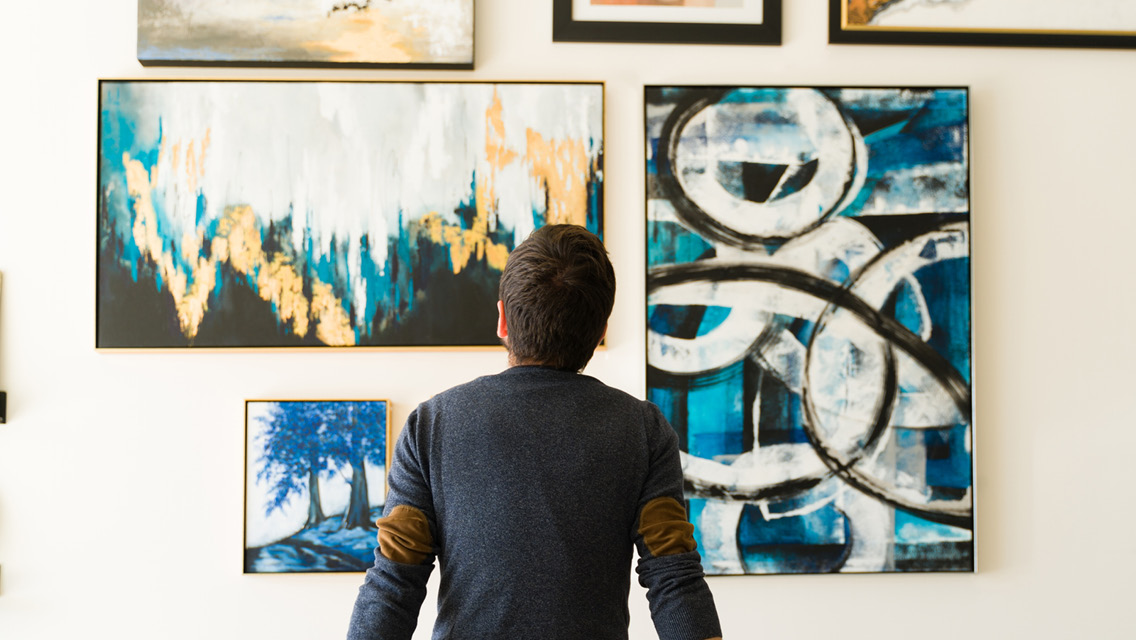Leonardo da Vinci, the prototypical Renaissance man, believed that appreciating sensory delights was one of the secrets to inspiring creativity and happiness. Leonardo understood that the impressions we experience every day serve as nourishment for the soul, and that without conscious attention, it’s all too easy for us to take in the sensory equivalent of junk food.
Leonardo once noted that the average person “looks without seeing, listens without hearing, touches without feeling, eats without tasting, moves without physical awareness, inhales without awareness of odor or fragrance, and talks without thinking.”
If that was true five centuries ago in Tuscany, it is certainly true today, when we are increasingly subject to the numbing effects of the lowest-common-denominator, mass-market “McWorld.”
The good news is that we also have unprecedented access to the sensory treasures of the world. We can easily, and with minimal expense, surround ourselves with beautiful music, food, wine and art — and, in the process, experience a personal renaissance of sorts. These treasures all enrich the quality of our lives. And we can make their positive effects more memorable by practicing comparative appreciation.
When you listen to multiple versions of a musical composition, or compare and contrast three different dark chocolates or a flight of wines, your mind naturally attunes to the differences and similarities among them. You begin to notice greater subtleties, and you deepen your recall for the pleasurable experience.
Comparative appreciation “engages the mind in what psychologists call ‘deep processing,’” explains Vera John-Steiner, PhD, professor of education and linguistics at the University of New Mexico and author of Notebooks of the Mind. “The comparison process inspires more robust neural activity, more cognitive investment, thereby greatly enhancing memory.”
Gifts of the Present
The process of closely comparing two or more different things or experiences also requires a great deal of present-moment focus — a state of mind that researchers have come to associate with increases in happiness and satisfaction and reductions in anxiety and stress.
The key to getting the most out of comparative appreciation is to enjoy being fully aware of and invested in the experience without worrying about getting the wrong answer. Suspend your concerns about making a proper critical analysis and focus instead on contemplating open-ended questions such as these:
- How do I experience this (music, wine, art, food, sensation)? Take note of which of your senses (smell, sight, sound, taste, sensation) are involved. Keep in mind that the more senses you employ, the more complex experiences you’ll be likely to have. Also, experiment with blocking a sensation (plugging your nose or closing your eyes, for example) or rotating certain senses in and out of awareness to experience certain sensations more intensely.
- What sensations, feelings and associations does this experience inspire or evoke? As your body and mind respond to each experience, notice and describe any thoughts or feelings you find coming to the surface. Try to move beyond “like” and “dislike” to more precise terms and descriptions. Does the experience evoke excitement, pleasure, curiosity, relaxation? Does it trigger memories or call images to mind? Contrast the impressions you get from this experience with those evoked by the other items you’re comparing. You may be surprised to find yourself enjoying something that you weren’t expecting to care for or being unimpressed by something you always thought you enjoyed.
- Which of these things do I prefer, and why? Very often, you’ll find that you have a strong preference for one or two of the compared items — in which case, you may learn some things about yourself. (Keep in mind, though, your tastes are likely to evolve as you continue with your comparative appreciation exercises.) Other times, you may feel ambivalent, or incapable of picking a favorite. That’s fine, too. It’s not a contest. The magic happens during the process of the comparative appreciation, not in the outcome.
The beauty of all these questions is that they have no wrong answers. As we free ourselves from the fear of saying something wrong or embarrassing, we allow ourselves to access deeper appreciation and enjoyment. We refine our senses and nurture our latent creativity. Best of all, when approaching experiences with appreciative inquiry, we also tend to enjoy higher levels of pleasure, the neurological and biochemical effects of which trigger mood-brightening and energizing endorphins.
Ready to get started? Try one or more of the exercises below. Then start thinking of some comparative appreciation opportunities of your own and noticing how other opportunities arise in the course of daily life. Do you prefer the roasted cauliflower or the sautéed? How does the flavor of water vary with or without an ice cube? How would you describe the different feelings you get from a yoga class and a strength-training workout? As you invest yourself in more fully evaluating the richness inherent in everyday experiences, you’ll find your appreciation of them increasing in similar measure.
Sharpen Your Senses
Consider the following comparative appreciation exercises as a starting place. Choose a time and place that allows you to focus your attention. You can enhance your experience further by recording your impressions in a notebook or sharing them with a friend.
Find a piece of music that you consider uplifting and inspiring. Seek out renditions performed by different artists, or if it is an orchestral piece, you can listen to the music played by the same orchestra but with different conductors.
Multiple Mozart. Compare at least two versions of the exquisite Mozart Concerto for Flute, Harp and Orchestra in C, K. 299, second movement, Andantino. (Renditions by the London Symphony Orchestra and the Chamber Orchestra of Europe are easy to find.)
Beethoven to Brahms. Listen to Beethoven’s Ninth Symphony. For a revealing study in contrasting styles, compare the version conducted by Leonard Bernstein with the one conducted by Herbert von Karajan. It’s the same incredible music, but the differing interpretations will make it easy to deepen your appreciation of this transcendent work.
After you spend some time with Beethoven, listen to Brahms’s Symphony no. 1. Compare the version conducted by Claudio Abbado with the one led by Karajan (both with the Berlin Philharmonic).
After you’ve enjoyed Beethoven and Brahms individually, listen to Beethoven’s Ninth and then listen to the Brahms piece. Brahms aimed to pay tribute to the genius of Beethoven while crafting his own original masterpiece. What similarities can you discern between the two works?
Of course, the delights you can compare are limitless. Try anything from apples (what’s the difference in scent, taste and texture between McIntosh, Cortland and Fuji?) to essential oils (enjoy a comparison of eucalyptus, lavender and rose).
As you explore the comparative appreciation of sensory delights, you will discover a simple secret for bringing more wonder, awareness and enjoyment into your everyday life.
Exquisite Comparisons
We are all born curious, but as the years go by, the pressures, stresses and habits of life can drain our passion, dull our sensitivity and dim our essential radiance. How can we revitalize our curiosity and sharpen our senses? One of the simplest and most delightful ways is to use comparative appreciation on a range of sensory treats.
Try these exercises:
Wine
Find a type of wine that you enjoy — Pinot Noir, for instance — and then get two or more bottles from the same year but from different vineyards, regions or producers. For example, try the 2007 Paraiso Pinot from California’s Santa Lucia Highlands and compare it with the 2007 Beringer Pinot Noir from Napa Valley.
You can make this exercise more fun, and more affordable, by sharing the cost with a group of friends. As you compare the wines made from the same grape in the same year, you’ll enjoy noticing telltale traces of each wine’s microclimate, soil and wine-making style. (For more advice on this comparative approach to wines, see “The Instant Wine Expert”.)
Art
The art appreciation equivalent of a horizontal wine tasting is the comparison of two artists from the same period of time, such as Manet and Monet. Both artists were born in Paris — Manet on Jan. 23, 1832; Monet on Nov. 14, 1840 — and they each played an important role in the evolution of Impressionism. They were friends and admired one another’s work, but their styles are dramatically different.
Here are paintings to inspire you to compare their styles and then share your impressions:
- Monet: Haystacks (Monet’s comparative study of the light falling on haystacks at different times of the day), The Water Lily Pond, and Impression, Sunrise.
- Manet: The Absinthe Drinker, Olympia and Luncheon on the Grass
Chocolate
For a delicious and affordable treat, buy small single bars (or a single chocolate) of three different intensities from an artisanal chocolate maker. You might start with Scharffen Berger (62 percent, 70 percent and 82 percent cacao content) or Theo (look for their Origin signature line; 74 percent, 75 percent and 84 percent cacao). Then enjoy a delicious comparative tasting, chewing slowly and savoring the aroma, texture and flavor of each bite. Take a few moments to appreciate the aftertaste, too: Throughout the tasting cycle, great chocolate expresses the unique properties of the soil and microclimate where it was cultivated.
As you explore the cacao percentage that you prefer, you can begin comparing chocolates from different producers with the same cacao percentage. For advanced appreciation, you can try chocolate from single-origin beans from different producers or you can create a theme around chocolates from different countries, such as Madagascar, Ghana, Indonesia or Venezuela.
Flowers
Buy (or pick) a few different kinds of roses, tulips, orchids or whatever flowers you like. Spend a few minutes, preferably with a loved one, describing the colors, scents and textures and the impressions they evoke.
This article has been updated and originally appeared as “Compare, Contrast, and Enjoy” in the April 2010 issue of Experience Life .




This Post Has 0 Comments